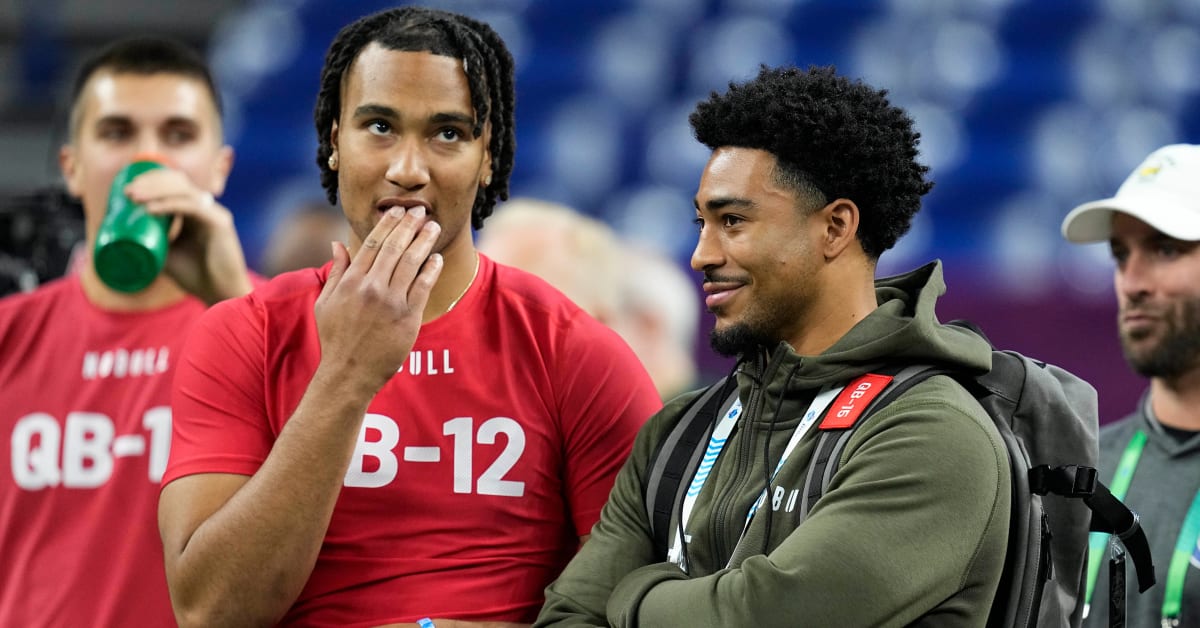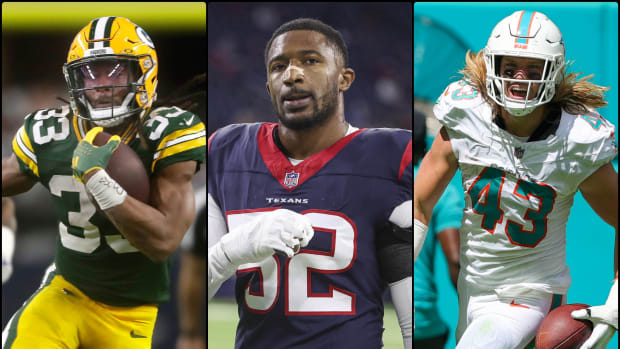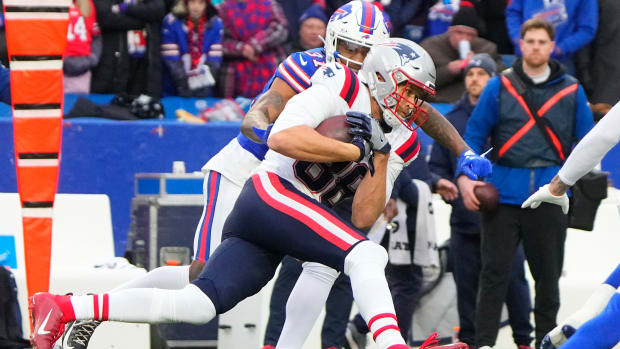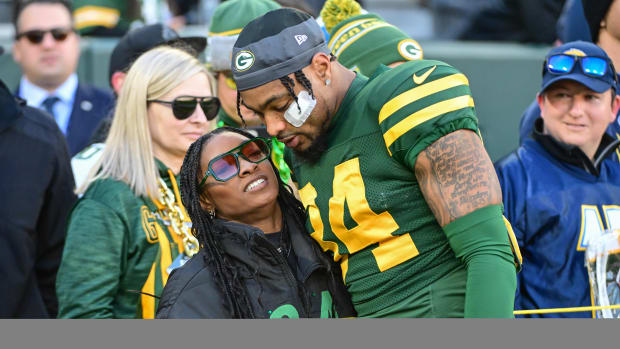
Why the Colts Prefer Scouting Top QBs Privately Over ‘Dumb’ Pro Days
As a programming note, we’ll roll out the Monday Afternoon Quarterback on Tuesday mornings for the rest of the offseason. It won’t change much, other than when you get it. And with that, let’s go …
• The Colts kicked off the week with a contingent in Southern California, working out both Alabama QB Bryce Young and Ohio State QB C.J. Stroud. These workouts have to occur, by rule, either on campus or near the player’s hometown. That Young and Stroud are both from Southern California and doing their draft prep there made it easy for Indy to knock both out at once.
The Indy group will be in Lexington to work out Kentucky QB Will Levis on Thursday, and they’ll get to Florida’s Anthony Richardson in their travels, too. And this is a pretty nice window into how Colts GM Chris Ballard runs his shop.
The Colts didn’t have a rep at Kentucky’s pro day a couple of weeks ago. They had only area scout Mike Lacy at Ohio State two days before that. And while top exec Morocco Brown attended Alabama’s pro day in between those two, he wasn’t exactly joined by an armada of lieutenants. That was in stark contrast to how the Panthers have handled all this (with about a dozen folks, and a digital media team on top of that, traveling to the QB pro days).

The Colts prefer to scout the draft's top quarterbacks such as Stroud and Young in private workouts.
Darron Cummings/AP
What does it mean? Well, I asked an exec from another team why his club sent only a single scout to one of the most prominent pro days, and his response was pretty direct and to the point: “Pro days are dumb.” Maybe Ballard doesn’t feel that strongly about it—but he’s clearly comfortable working off the tape from these dog-and-pony shows and more focused on getting the players in close quarters (be it in private workouts or visits).
And one good example of that came last year, when Ballard led a group of Colts officials on the 90-minute drive to work out Cincinnati QB Desmond Ridder at the Bearcats’ practice facility. Indy didn’t wind up drafting Ridder, but it did use a second-rounder on one of the guys he was throwing to that day, Alec Pierce.
• We’ve mentioned that Tennessee QB Hendon Hooker is seen, by some, as a better prospect than Richardson or Levis. It’s interesting, then, that the Colts brought him in for a top-30 visit earlier in the process. Logical, too.
With Hooker’s ACL injury, the Colts couldn’t work him out on campus like the others. And on a top-30 visit, teams can give players a physical—meaning Indy got a close look at Hooker’s progress back from the knee injury he suffered in November. Indy also could get him on the board and in the film room to see how steep the learning curve would be for him coming from Tennessee’s version of the old Baylor Air Raid.
So if the Colts don’t love their quarterback options at No. 4? Hooker could give them a trade-back-into-the-bottom-of-the-first-round option later on.
• I picked up a few more things on the Thursday Night Football flex debate after writing the Monday morning story on it, and one I thought should be explained here is why the NFL will have to go back to CBS and Fox to negotiate on a potential longer runway for flexing games into that window.
As we wrote Monday, a big reason the Broncos and Panthers abstained from the flex vote was because both Denver CEO Greg Penner and Carolina owner David Tepper insisted on 28 days of notice that a game was being flexed—the proposal called for a 28-day warning that a game could be flexed, then 15 days notice that it definitely would be flexed. And while that ask from Penner and Tepper wasn’t shot down out of hand, it did require more negotiation.
As it stands right now, Fox and CBS can choose to protect games from being flexed within a 15-day window, which has matched up with the window the league has to flex games into Sunday Night Football on NBC. So that, obviously, would have to be adjusted. And there’d have to be some negotiation, because it might be tough for Fox and CBS to know which games they’d want to protect a full month out.
We also mentioned in the Monday column how Tepper asked, “Is Amazon complaining?” Another owner speaking on the floor after Tepper posed this question: “Why would we give this to them for free?” The truth, again, seems to be more that the NFL sees it as important that it’s giving the streaming service a needle-moving product, so it can get the other streaming services, which were lukewarm during the last set of broadcast talks, excited about bidding in seven years.
It’s fair to say all this is in a tenuous spot going into May.
• And, by the way, there are opponents to the proposal.
“I’m not a proponent of flexing Thursday night games,” says one NFC exec. “Being able to play twice on Thursdays [in the same season], I don’t think anyone thought that was a big deal. I’m more of the opinion, the flexing, to me, I don’t think is necessary. The league’s perspective is, we’re probably talking about one game getting flexed per year. So, ultimately, I think all this is overblown. Is it necessary? Probably not.”
So where is all of this going? The schedule release in May, which will happen a week or two before the next owners meetings in Minneapolis May 22 to 24, will give fans an indication of what this all means. This exec guessed we’ll see teams not typically scheduled for late-season Thursday night games—such as the Cowboys, Steelers and Packers—in those slots, which would make flexing a lot less relevant.
• One more thing I thought was kind of funny here—this has become a problem only because the NFL doesn’t have NFL Network to hide bad matchups anymore. In the past, about half the slate would be exclusive to the league’s in-house network, which is where the proverbial AFC South color-rush game would be stashed.
“Who was the NFL gonna b---- to on those?” an exec says. “Themselves?”

Carter could fall out of the top 10 in the draft because of off-field issues.
Mark J. Rebilas/USA TODAY Sports
• Interesting decision by Drew Rosenhaus to limit polarizing Georgia prospect Jalen Carter’s visits to teams picking in the top 10.
Upon arrest warrants being issued for Carter during the scouting combine—which added to questions already out there with teams on the blue-chipper’s football character—teams picking further down the line in the draft really started to dig in on the Georgia star, preparing for the event he falls to them. This sort of thing isn’t all that unusual. You’ll remember in 2016, when teams that thought Laremy Tunsil would never be available to them, were sent scrambling on draft night after the gas-mask video surfaced on social media.
For what it’s worth, I don’t think the idea of Carter slipping out of the top 10 is all that far-fetched based on what I know about where teams stand on him. He’s probably the best player at any position in this year’s class. In fact, a bunch of evaluators I really respect considered him the best prospect on the 2021 Georgia defense, when he was just a sophomore and the Bulldogs had five ’22 first-rounders on that side of the ball alone. But there are enough off-field concerns about Carter to scare teams out of investing a top-10 pick in him.
That said, Rosenhaus is experienced with this stuff, and I’d bet there is sound reasoning behind his strategy. Carter’s case, among NFL teams, is often compared to Warren Sapp’s from 28 years ago. Sapp, a similar type of player who’s actually from the same high school in Florida as Carter (Apopka High), fell to the 12th pick that year after word of failed drug tests at Miami got filtered through to teams. Sapp’s agent for that? Rosenhaus.
Anyway, I’d expect Carter’s fate to be among the most intriguing stories of the first night of the draft (April 27). And with the potential for four quarterbacks to go in the top 10, there are a lot of variables at play on how far he might slip.
• Speaking of Rosenhaus, his strategy was sound with another of his clients. Darius Slay made it clear from the start that he didn’t ask for a trade from Philadelphia—which subsequently made it clear that Rosenhaus getting permission to seek one was simply part of the negotiation on a reduced contract.
In the end, Slay clearly wanted to stay in Philly, and so everyone wins with Slay coming back on a deal that, on paper, is for three years, but is more realistically a very fair, two-year, $24.5 million pact. And give Eagles GM Howie Roseman credit, too. It seemed highly unlikely he’d be able to bring back both his starting corners after the year that defense had in getting to the Super Bowl.
In the end, he did just that, getting both signed through 2025.
• It’ll be interesting to see what the collapse of the running back market will mean for tagged tailbacks Saquon Barkley, Josh Jacobs and Tony Pollard between now and mid-July.
A close look shows that the top three earners on this year’s market had APYs (average per year) of $6.35 million (Miles Sanders in Carolina), $6 million (David Montgomery in Detroit) and $4 million (Jamaal Williams in New Orleans). That’s a far cry from the $10.1 million tags the aforementioned three were assigned, all of whom, to be fair, are better players than the guys who were on the market.
It certainly stands to reason that—for the Giants, Raiders and Cowboys—the best move might be to let the players play on the franchise tag.
• Where Texas running back Bijan Robinson will go in three weeks is also among the most interesting story lines of the draft. I’ve been told by a bunch of teams that Robinson is at the same level as Barkley and Zeke Elliott—two of just three backs to go top five in the last 10 drafts—were coming out. But given the devaluing of the position, it seems there’s almost no shot he’ll go that high.
How far will he slip? I’m not sure, but where he gets selected will tell us plenty about how the position is being viewed in today’s game, especially when, at least on paper, you’re getting a running back’s best years while he’s on his rookie contract.
• Great to see Damar Hamlin with President Joe Biden, and then David and Nicole Tepper, trying to use his newfound platform to make a difference for others.





































